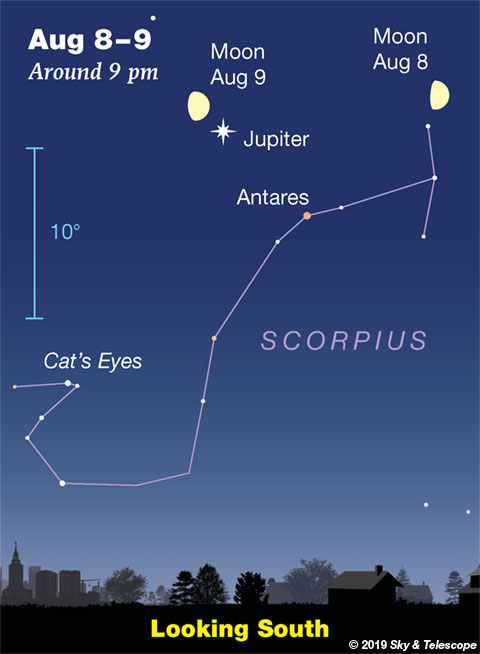
Friday, August 9
• The waxing gibbous Moon shines near Jupiter this evening, as shown here. But Jupiter, 40 times larger than the Moon, is currently 1,830 times farther away.
Jupiter's own four big moons, roughly as big as ours, are pinpoints in a small telescope or good, steadily braced binoculars. They're lined up east and west of the planet. This evening you'll find Europa to Jupiter's east and Io, Callisto, and Ganymede to its west, counting outward. See the guide to Jupiter's moons for every night in August, good worldwide, in the August Sky & Telescope, page 51.
Saturday, August 10
• Narrow windows for good Perseid viewing. The annual Perseid meteor shower is predicted peak late on the night of August 12-13, but the waxing gibbous Moon won't set that night until just before the beginning of dawn.
You may do better a day before that, on the morning of the 12th, if you catch the hour or so of dark sky between moonset and the start of dawn (for North America). And, there's a possibility this year of a second peak in the meteor rates due right around then for North America (around 10h UT August 12th).
A day earlier on the morning of the 11th — late tonight, in other words — we get two dark hours before dawn, but the meteor rates will probably be low. However, there are indications that this year's Perseid shower is bringing some unusual early fireballs.
Not sure when dawn begins? At this time of year it's about 1 hour 45 minutes before your local sunrise time if you're in the world's midnorthern latitudes (near 40° N.)
Here's the International Meteor Organization's near-real-time graph of Perseid activity this year, based on scientific, standardized-method meteor counts coming in from visual observers around the globe.
Sunday, August 11
• The Moon shines with Saturn tonight, 3° or 4° to Saturn's right as seen during evening in North America.
Physically Saturn is 35 times as large as the Moon (not counting the rings), and tonight it's 3,500 times farther away.
Saturn's own largest satellite, Titan, is 1.5 times as large as our Moon. A small or medium-size telescope shows it tonight as an 8.5-magnitude orange pinpoint, about four ring-lengths to Saturn's west.
Monday, August 12
• It's supposed to be peak Perseid night, but you'll have the bright light of the waxing gibbous Moon washing the sky, so only the brightest meteors will show through. Best time: the later in the night the better, right up to the beginning of Tuesday's dawn.
Not sure when dawn begins? It's about 1 hour 45 minutes before your local sunrise time if you're in the world's mid-northern latitudes (near 40° N.)
Tuesday, August 13
• The nights around full Moon, such as now, are traditionally considered the worst for lunar observing. But not if your interest is crater rays! These show best under high, shadowless illumination. To go exploring, see Chuck Wood's "Unruly Crater Rays" in the August Sky & Telescope, page 52. Do you know about the hill-blocked ray pattern of Kepler?
Wednesday, August 14
• Full Moon tonight and tomorrow night. The actual moment of full Moon is 8:29 a.m. tomorrow morning EDT. So for evening skywatchers in the time zones of the Americas, both this evening and tomorrow evening qualify as "full moon" about equally.
Tonight the Moon is in dim Capricornus. Tomorrow it'll be just across the constellation border into dim Aquarius.
Thursday, August 15
• Different people have an easier or harder time seeing star colors, especially subtle ones. To me, the tints of bright stars stand out a little better on a bright sky background — such as we have with the moonlight tonight.
For instance, the two brightest stars of summer are Vega, overhead soon after dark, and Arcturus, shining in the west. Vega is white with just a touch of blue. Arcturus is a yellow-orange giant. Do their colors stand out a little better for you in moonlight or in late twilight?
Binoculars, of course, always make star colors easier.
Friday, August 16
• As August proceeds and nights begin to turn chilly, the Great Square of Pegasus lifts up in the east, balancing on one corner. Its stars are only 2nd and 3rd magnitude, and your fist at arm's length fits inside it. Late this evening the waning gibbous Moon rises below it.
From the Square's left corner extends the main line of the constellation Andromeda: three stars (including the corner) about as bright as those forming the Square.
This whole giant pattern was named "the Andromegasus Dipper" by the late Sky & Telescope columnist George Lovi. It's shaped sort of like a giant Little Dipper with an extra-big bowl, and it's currently raising its contents upward.
Saturday, August 17
• The actual Little Dipper, meanwhile, is tipping far over leftward in the north. It's less than half as long as the Andromegasus Dipper, and most of it is much fainter. As always, you'll find that it's oriented more than 90° counterclockwise compared to Andromegasus.
________________________
Want to become a better astronomer? Learn your way around the constellations. They're the key to locating everything fainter and deeper to hunt with binoculars or a telescope.
This is an outdoor nature hobby. For an easy-to-use constellation guide covering the whole evening sky, use the big monthly map in the center of each issue of Sky & Telescope, the essential guide to astronomy.

Once you get a telescope, to put it to good use you'll need a detailed, large-scale sky atlas (set of charts). The basic standard is the Pocket Sky Atlas (in either the original or Jumbo Edition), which shows stars to magnitude 7.6.
Next up is the larger and deeper Sky Atlas 2000.0, plotting stars to magnitude 8.5; nearly three times as many. The next up, once you know your way around, are the even larger Interstellarum atlas (stars to magnitude 9.5) and Uranometria 2000.0 (stars to magnitude 9.75). And read how to use sky charts with a telescope.
You'll also want a good deep-sky guidebook, such as Sue French's Deep-Sky Wonders collection (which includes its own charts), Sky Atlas 2000.0 Companion by Strong and Sinnott, or the bigger Night Sky Observer's Guide by Kepple and Sanner.
Can a computerized telescope replace charts? Not for beginners, I don't think, and not on mounts and tripods that are less than top-quality mechanically (meaning heavy and expensive). And as Terence Dickinson and Alan Dyer say in their Backyard Astronomer's Guide, "A full appreciation of the universe cannot come without developing the skills to find things in the sky and understanding how the sky works. This knowledge comes only by spending time under the stars with star maps in hand."
This Week's Planet Roundup
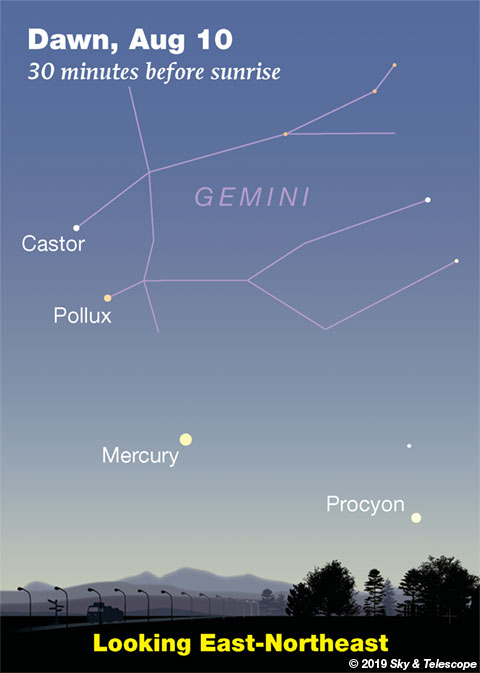
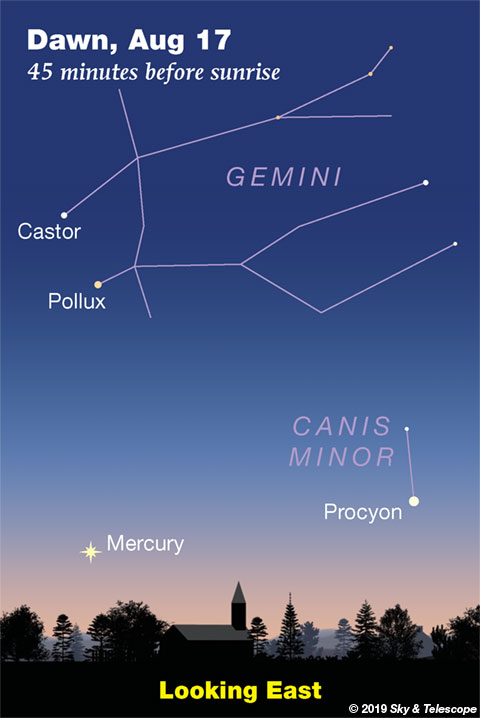
Mercury displays itself low in early dawn this week as it brightens from magnitude –0.2 to –0.8. Use binoculars to look for it very low about 45 minutes before sunrise. It's below or lower right of twinklier Pollux and Castor, as shown here. Don't confuse it with Procyon off to its right.
Venus and Mars are out of sight behind the glare of the Sun.
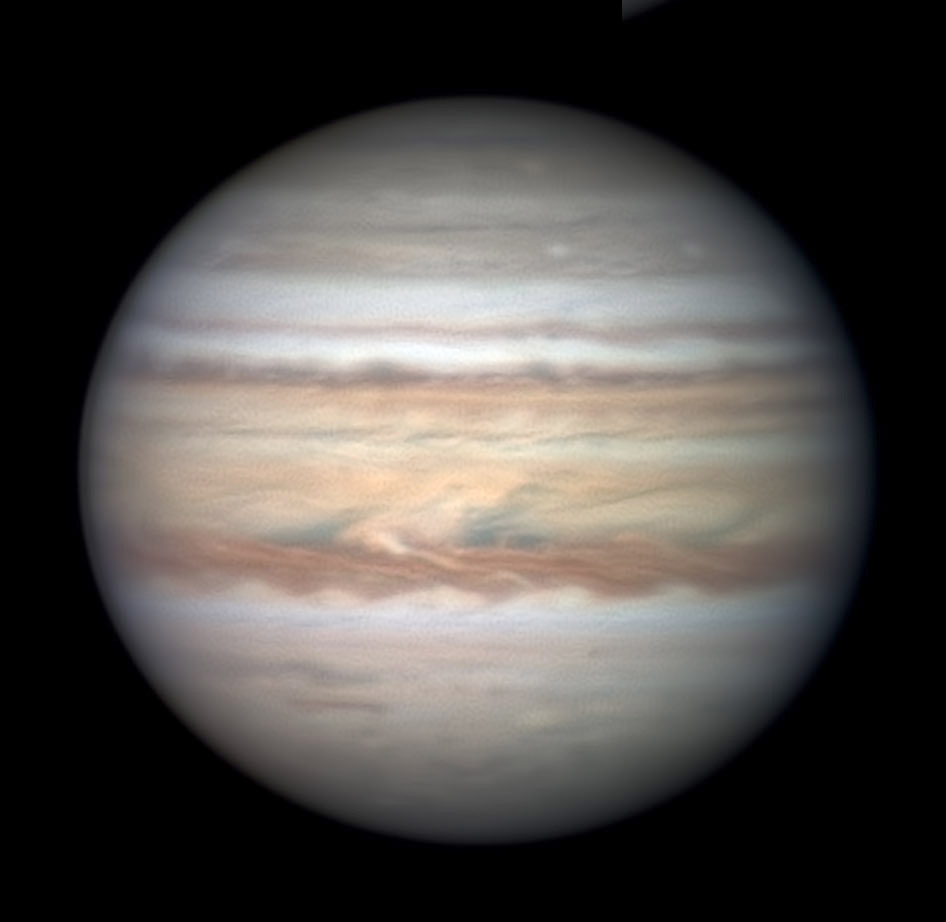
Jupiter (magnitude –2.3, between the feet of Ophiuchus) is the white dot in the south as twilight fades. Jupiter starts getting lower in the south-southwest soon after dark. Orange Antares, much fainter at magnitude +1.0, twinkles 7° to its lower right.
Jupiter and Antares form a shallow, nearly isosceles triangle with Delta Scorpii (Dschubba) to their right. Delta, a long-term eruptive variable of the Gamma Cassiopeiae type, has been only a little fainter than Antares for most of the last 19 years — after it brightened by some 50% in July 2000.
In a telescope Jupiter is 41 arcseconds wide and shrinking gradually. See Bob King's observing guide to Jupiter.
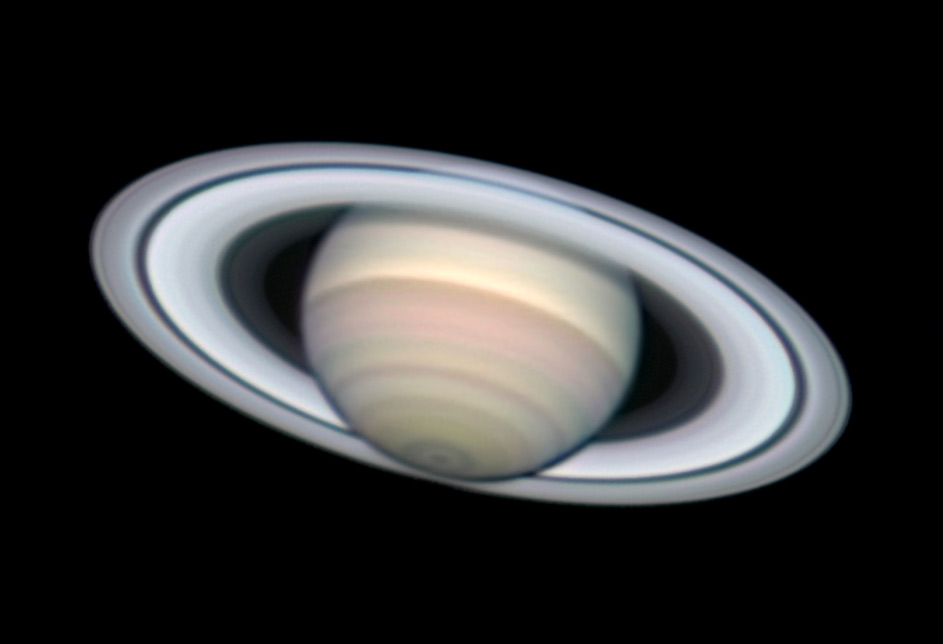
Uranus (magnitude 5.8, in Aries) is high in the southeast before the beginning of dawn.
Neptune (magnitude 7.8, in Aquarius) is well up in the southeast by 11 or midnight and highest in the south well before dawn. Finder charts for Uranus and Neptune.
_________________
All descriptions that relate to your horizon — including the words up, down, right, and left — are written for the world's mid-northern latitudes. Descriptions that also depend on longitude (mainly Moon positions) are for North America.
Eastern Daylight Time (EDT) is Universal Time (UT, UTC, GMT, or Z time) minus 4 hours.
_________________
Audio sky tour. Out under the evening sky with your earbuds in place, listen to Kelly Beatty's monthly podcast tour of the heavens above. It's free.
_________________
“This adventure is made possible by generations of searchers strictly adhering to a simple set of rules. Test ideas by experiments and observations. Build on those ideas that pass the test. Reject the ones that fail. Follow the evidence wherever it leads, and question everything. Accept these terms, and the cosmos is yours.”
— Neil deGrasse Tyson, 2014
 10
10








Comments
misha17
August 9, 2019 at 2:15 pm
"This whole giant pattern was named "the Andromegasus Dipper" by the late Sky & Telescope columnist George Lovi. It's shaped sort of like a giant Little Dipper with an extra-big bowl, and it's currently raising its contents upward."
And like the leading (western) stars of the Big Dipper, the 2 stars along the western edge of the Great Square point north to Polaris. In fact, the leading stars of the Big Dipper and the Great Square are almost exactly 12 apart in Right Ascension.
You must be logged in to post a comment.
Rod
August 12, 2019 at 9:59 am
mary beth, any stargazing lately? I did observe some Perseids, posted some notes at Bob King's report.
You must be logged in to post a comment.
mary beth
August 13, 2019 at 12:21 am
Hi Rod! We’ve had some really nice clear nights! However it is been so hot, the heat index was 111 yesterday! We do not get out of the 80s even during the night! However it was gorgeous to see Jupiter and the moon the other night, and it was also pretty last night between the two planets. I’ve been enjoying the little I can see of the corona borealis. How have things been in Maryland?
You must be logged in to post a comment.
Rod
August 13, 2019 at 8:12 am
mary beth, good to hear from you. Weather in Maryland was pretty good lately, since 09 through 12th of August. Mostly clear skies at night with temps in low to mid-60s. I did get out and enjoy using my 90-mm refractor and 10-inch Newtonian, the Moon, Jupiter, and Saturn - some great views. Early mornings just before 0400 on the 10th and 12th, I was out enjoying some Perseids. I logged at least 8 observed in my stargazing database. Fall is in the air. The bucks are moving around in the woods and calling and Great Horn owls are hooting. I hoot too and sometimes, call a few owls in close to me when observing 🙂 We have a *hoot* of a time then 🙂
You must be logged in to post a comment.
mary beth
August 13, 2019 at 1:42 pm
You really get to enjoy the season is there...so happy for you! That is something we can’t really do here in Houston. Glad you saw some meteors too! Bet it was very exhilarating! This is a wonderful time of year. Funny you mentioned owls because I rarely see them in my neighborhood, I usually only see them when I visit friends who live in the outskirts of town. But just last night about 10 o’clock I heard an owl in my neighbors tree and I was thrilled. Hoping to see and to hear it every night! Love to see them in their majestic quiet flight! Happy Late Summer!
You must be logged in to post a comment.
Rod
August 15, 2019 at 12:59 pm
mary beth, you said "You really get to enjoy the season is there…" Not too fast here 🙂 This weekend and next week, looks like temps in low 90s again here 🙂 Last night I was out looking at Jupiter and the Great Red Spot from 8:00 PM until 8:45 PM EDT. Sky & Telescope August issue (page 51) showed the Great Red Spot crossing central meridian near 8:11 PM EDT or 0011 UT on 15th. I enjoyed the views using my telescope but it was muggy so I did not stay out very long 🙂
You must be logged in to post a comment.
Anthony Barreiro
August 13, 2019 at 6:19 pm
The Uranus-Neptune finder chart is not very useful. Neptune, in Aquarius, is crammed into the lower right corner, and Uranus, in Aries, into the upper left corner, with the entire 45 degree expanse of Pisces between them. The stars of Pisces are no longer useful for finding Uranus, and they're not yet useful for finding Neptune. The closest naked-eye asterism to Neptune is the water jar of Aquarius, and the closest to Uranus is the horn of Aries -- but none of these stars are on the chart!
It made sense to use a single finder chart for Uranus and Neptune when they were conjunct in the early 1990's, but Uranus is pulling away from Neptune for the rest of our lifetimes. It's past time to put together separate finder charts for these two planets.
Using a 50 mm finder scope or binoculars, Neptune is an easy hop from Aquarius' water jar to Theta Aquarii to Phi Aqr. Uranus can be found most easily by following a curving cascade of stars south-southeast from Gamma Arietis.
You must be logged in to post a comment.
Anthony Barreiro
August 13, 2019 at 7:06 pm
Rereading this, "put together separate finder charts" is ambiguous. I should have said publish separate finder charts.
You must be logged in to post a comment.
Rod
August 13, 2019 at 7:37 pm
Anthony, I find Stellarium, Starry Night or SkySafari software works well. I frequently use those tools, especially Starry Night and Stellarium and save sky images for use. Periodically I check against USNO portal too for my location as a double check. When I stargaze, I have no GPS or other smart devices, just the night sky and trusty Telrad 🙂
You must be logged in to post a comment.
Anthony Barreiro
August 14, 2019 at 12:29 pm
Thanks Rod. I have Sky Safari on my laptop and ipad and find it very helpful for planning what I'm going to look at. When I'm out observing at night I prefer to use a printed chart and a dim red flashlight -- better for my dark adaptation, less cumbersome, and I don't need to worry about dropping an expensive electronic device. But I don't know how to print out charts from sky safari. I suppose I could download Stellarium and figure out how to create and print charts, but it's easier to just complain about the charts other people make for free.
You must be logged in to post a comment.
You must be logged in to post a comment.